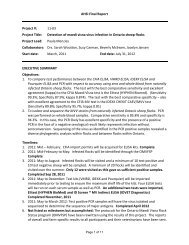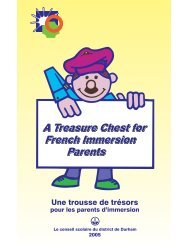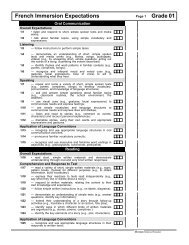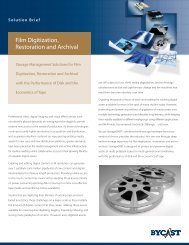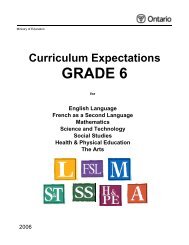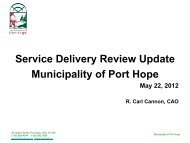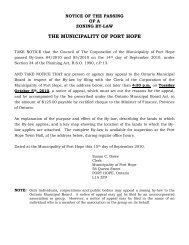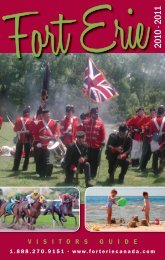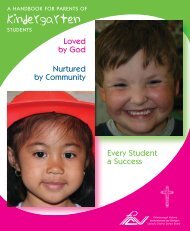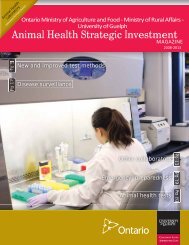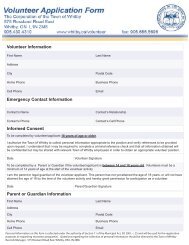GRADE 3 - PVNC Catholic District School Board
GRADE 3 - PVNC Catholic District School Board
GRADE 3 - PVNC Catholic District School Board
Create successful ePaper yourself
Turn your PDF publications into a flip-book with our unique Google optimized e-Paper software.
English Language Expectations<br />
Pg. 6 Grade 3<br />
Writing<br />
Overall Expectations<br />
3e44<br />
3e45<br />
3e46<br />
3e47<br />
1. generate, gather, and organize ideas and information to write for an intended purpose and audience;<br />
2. draft and revise their writing, using a variety of informational, literary, and graphic forms and<br />
stylistic elements appropriate for the purpose and audience;<br />
3. use editing, proofreading, and publishing skills and strategies, and knowledge of language<br />
conventions, to correct errors, refine expression, and present their work effectively;<br />
4. reflect on and identify their strengths as writers, areas for improvement, and the strategies they<br />
found most helpful at different stages in the writing process.<br />
1. Developing and Organizing Content<br />
3e48<br />
3e49<br />
3e50<br />
3e51<br />
3e52<br />
3e53<br />
Purpose and Audience<br />
1.1 identify the topic, purpose, audience, and form for writing (e.g., an original fable, modelled on<br />
the structures and conventions of fables read, to entertain the class; a scientific explanation<br />
demonstrating how some common levers make work easier, for a peer group; a labelled map<br />
with a legend identifying the key components of an early settlement in Upper Canada, to<br />
accompany a small-group project)<br />
Teacher prompts: “What is your writing about?” “Why are you writing?” “Whom are you writing<br />
for?”<br />
Developing Ideas<br />
1.2 generate ideas about a potential topic, using a variety of strategies and resources (e.g., formulate<br />
and ask questions to identify personal experiences, prior knowledge, and information needs<br />
and to guide searches for information; brainstorm and record ideas on the topic)<br />
Research<br />
1.3 gather information to support ideas for writing in a variety of ways and/or from a variety of sources<br />
(e.g., from discussions with family and friends; from teacher read-alouds, mentor texts, shared-,<br />
guided-, and independent-reading texts, and media texts)<br />
Classifying Ideas<br />
1.4 sort ideas and information for their writing in a variety of ways (e.g., by using graphs, charts,<br />
webs, outlines, or lists)<br />
Organizing Ideas<br />
1.5 identify and order main ideas and supporting details into units that could be used to develop a<br />
short, simple paragraph, using graphic organizers (e.g., a story grammar, a T-chart, a paragraph<br />
frame) and organizational patterns (e.g., comparison, chronological order)<br />
Review<br />
1.6 determine whether the ideas and information they have gathered are relevant and adequate for the<br />
purpose, and gather new material if necessary (e.g., discuss the content with a peer or reading<br />
buddy; review material using a story map or web)<br />
Ministry of Education 2006



